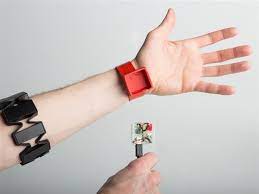Master thesis: Neuromorphic “Fitbit”: detect heart and movement activity to state estimation.

Figure 1 Example of 3D-printed bracelet for the wrist application
Developing a low-power wearable device to monitor elderly patients' heart rate and movements offers continuous, real-time health tracking. This facilitates early detection of health issues, including fall detection, leading to timely intervention.
The project comprises both hardware and software components. The hardware involves designing an analog front end with Photoplethysmography (PPG) and accelerometer (ACC) sensors to detect the subject's activity. The PPG sensor [1] measures heart activity, varying with blood volume, which is influenced by the heartbeat. It utilizes light (LEDs); specifically, lower reflected light intensity indicates higher blood volume and vice versa. This signal is commonplace and present in every smartwatch capable of measuring cardiac activity. Three ACCs (one for each direction) are employed to detect subjects' movement and direction. An analog solution [2] enables compact and powerful solutions that last longer than digital counterparts. Following the signal conditioning phase, the system should stream the data externally, both as raw data and after conversion into spikes. Various approaches can be explored, ranging from simple thresholding methods to more complex asynchronous delta modulation. Once spikes are generated, they can be streamed externally using low-power Bluetooth. At INI, we have a test bench for PPG and ACC sensors, intended for testing and miniaturization for incorporation into a bracelet.
The software segment involves processing PPG and ACC using neuromorphic hardware. The signals undergo a firing amplification phase (given their low frequency, in the order of a few Hz) and the creation of an amplifier network. Subsequently, the signals will be processed using a neural state machine [3] to comprehend the patient's state.
The project's outcome will be a bracelet for recording PPG and ACC signals (Fig 1), processed on a neuromorphic processor. The chosen neuromorphic mixed-mode processor is the DYNAPSE.
Collaboration on the hardware component can be undertaken with the Center for Project-Based Learning D-ITET in Zurich, under the guidance of Dr. Michele Magno.
Bibliography
[1] Park, Junyung, et al. "Photoplethysmogram Analysis and Applications: An Integrative Review." Frontiers in Physiology 12 (2022): 2511.
[2] Pandey, Rajeev Kumar, and Paul C-P. Chao. "An adaptive analog front end for a flexible PPG sensor patch with self-determined motion related DC drift removal." 2021 IEEE International Symposium on Circuits and Systems (ISCAS). IEEE, 2021.
[3] Liang, D., Kreiser, R., Nielsen, C., Qiao, N., Sandamirskaya, Y., & Indiveri, G. (2019). Neural state machines for robust learning and control of neuromorphic agents. IEEE Journal on Emerging and Selected Topics in Circuits and Systems, 9(4), 679-689.
Requirements
Programming skills in Python, knowledge of PCB design, and interest in wearable applications.
Contact
Elisa Donati elisa (at) ini.uzh.ch,